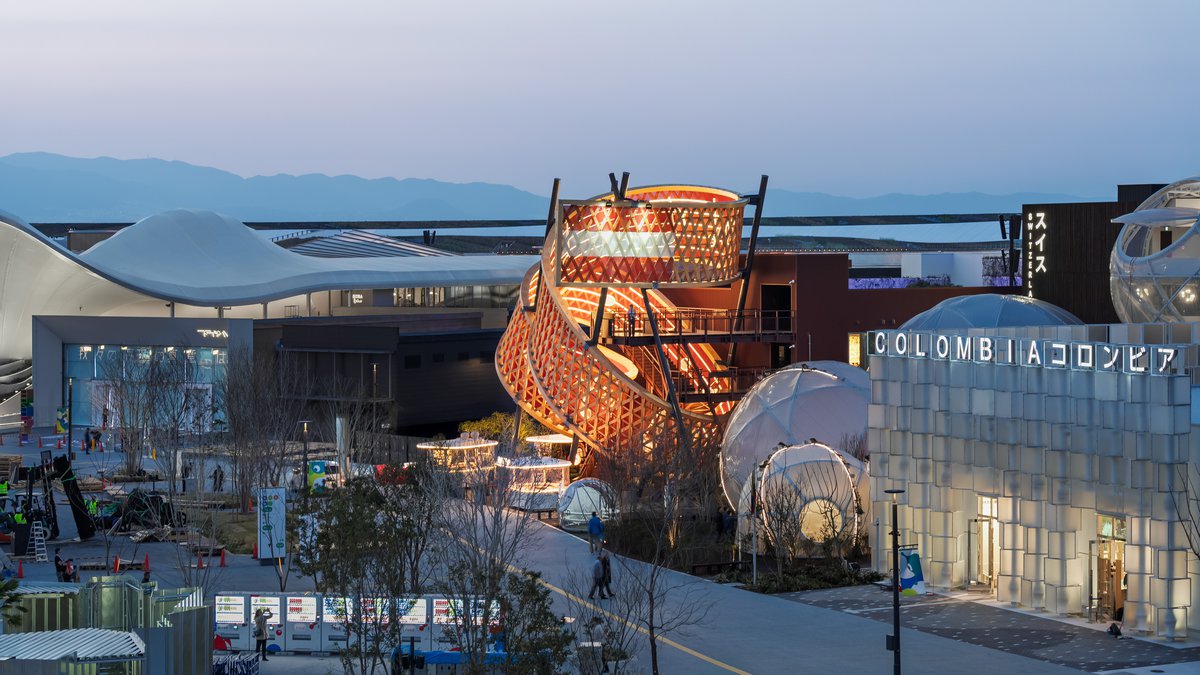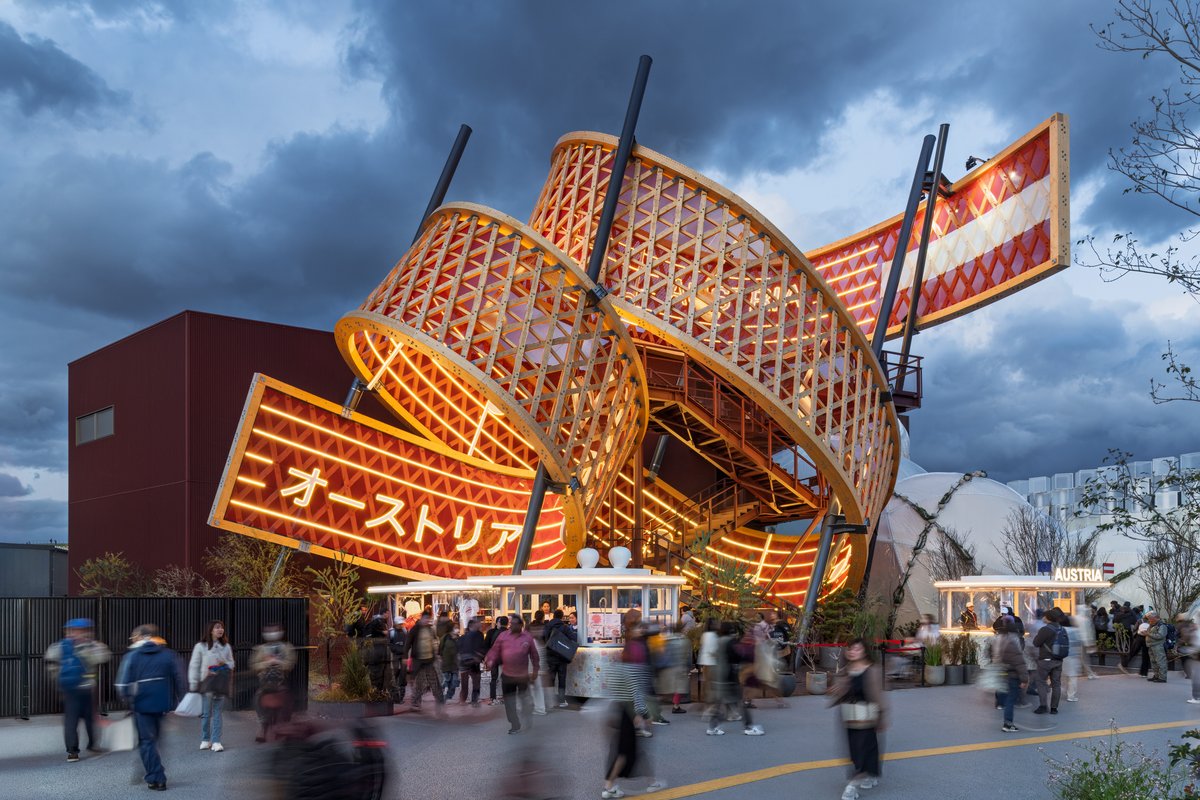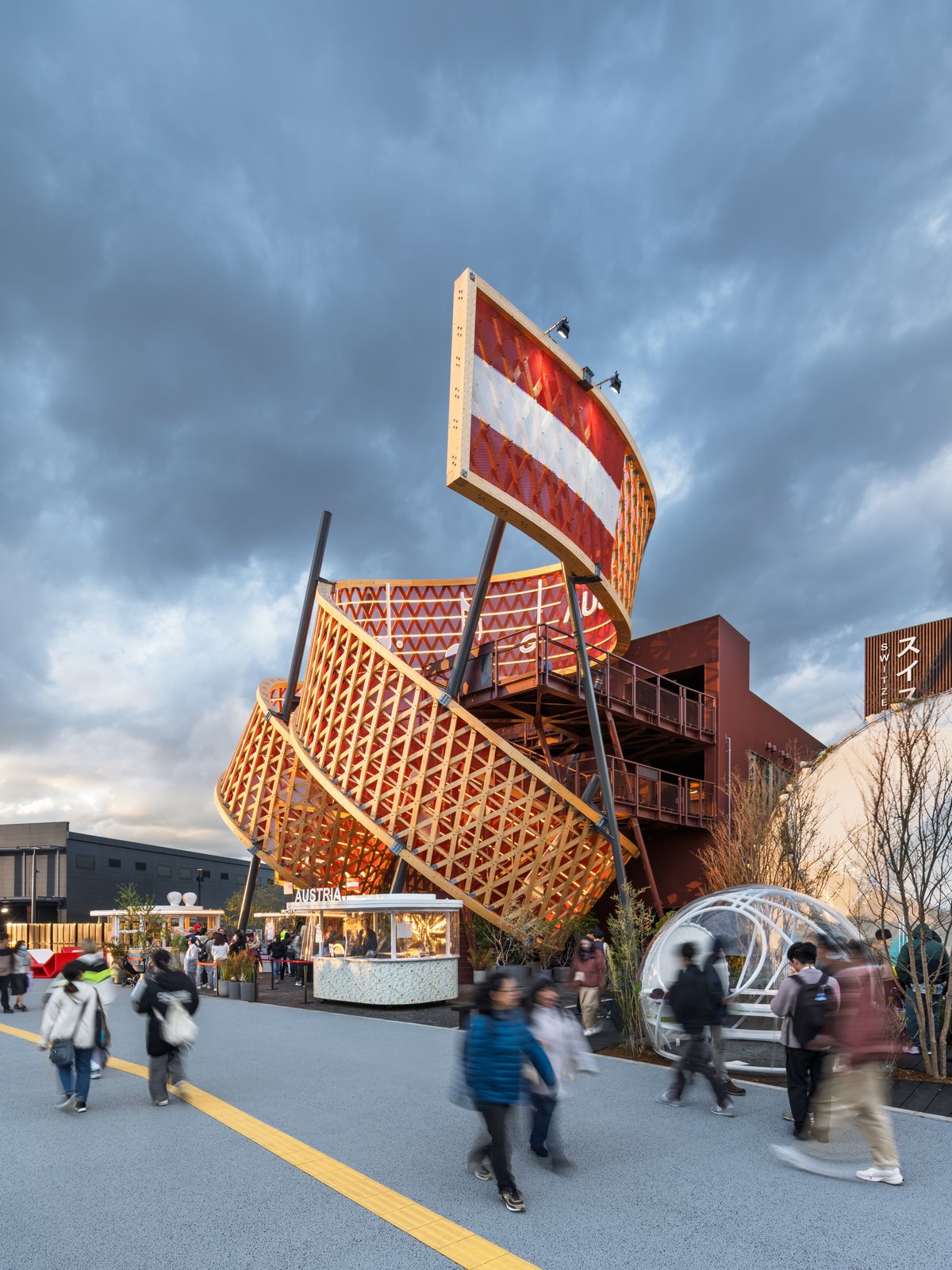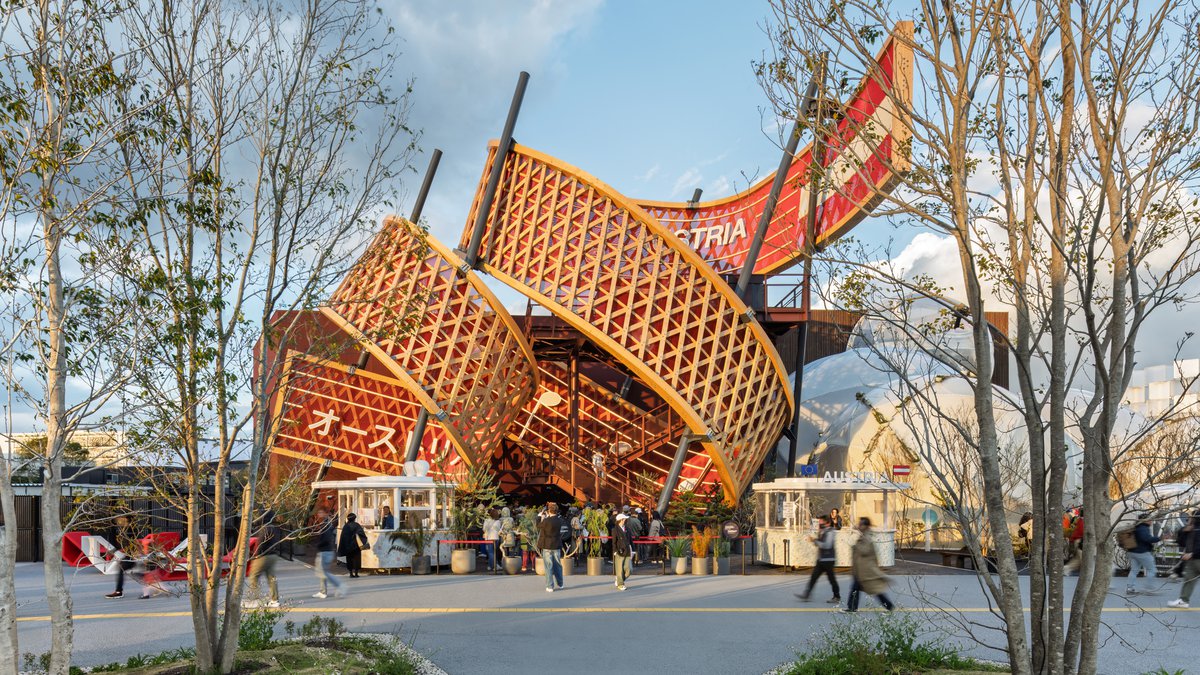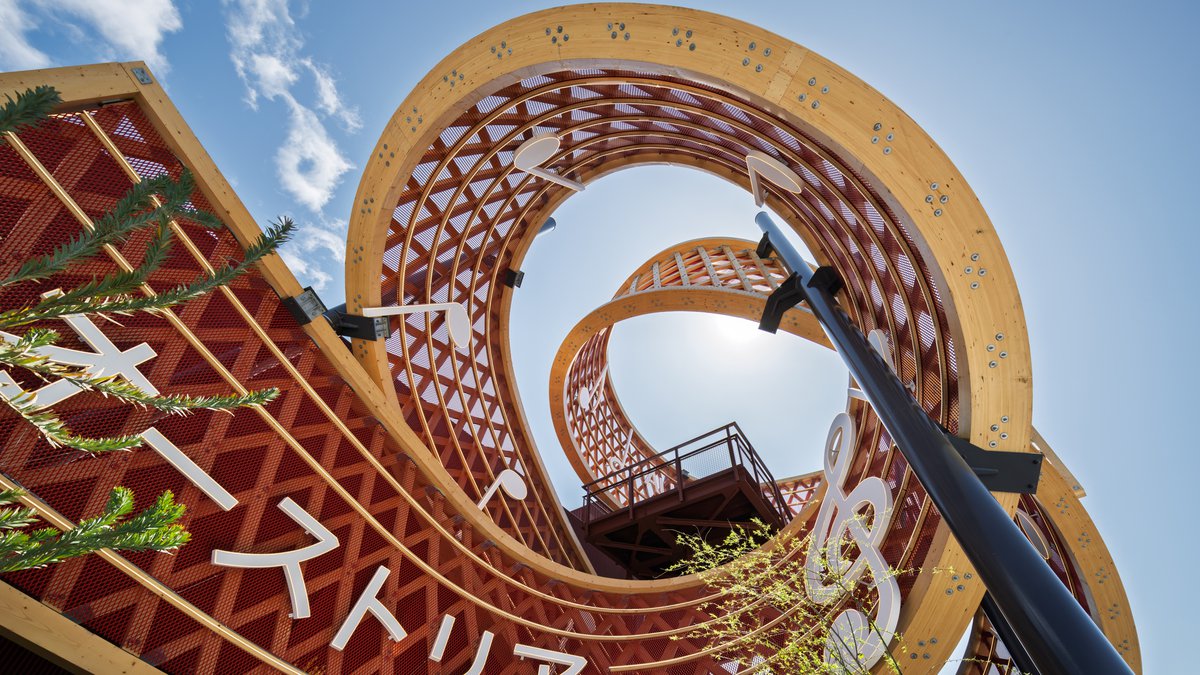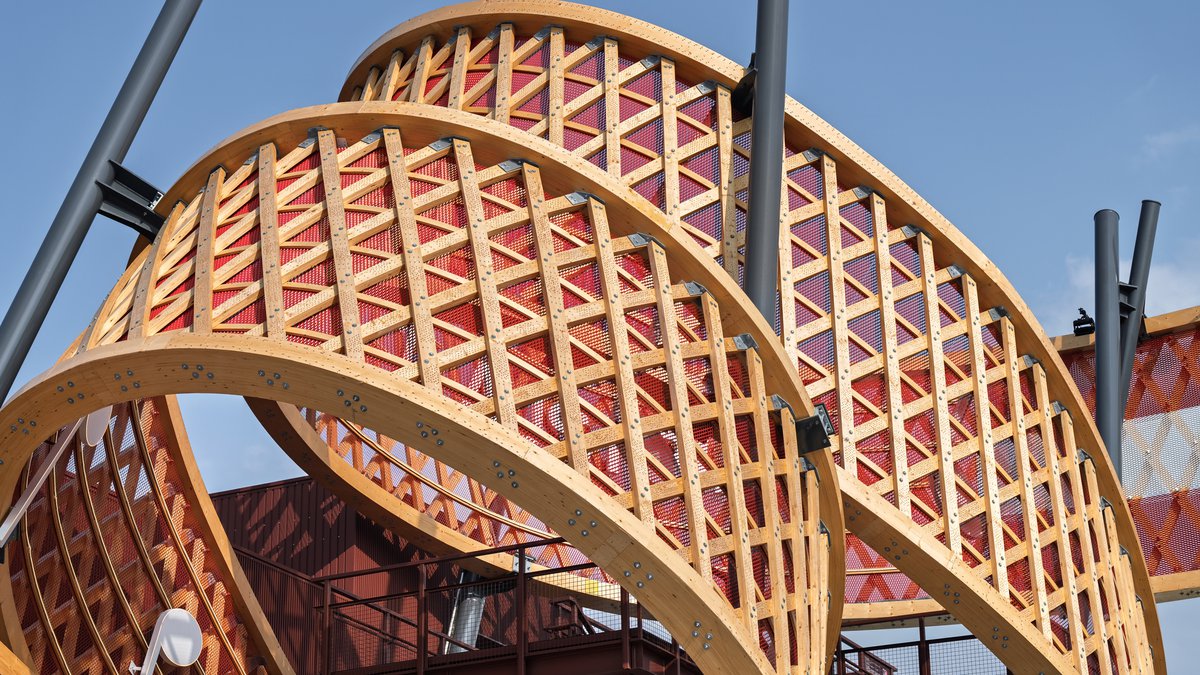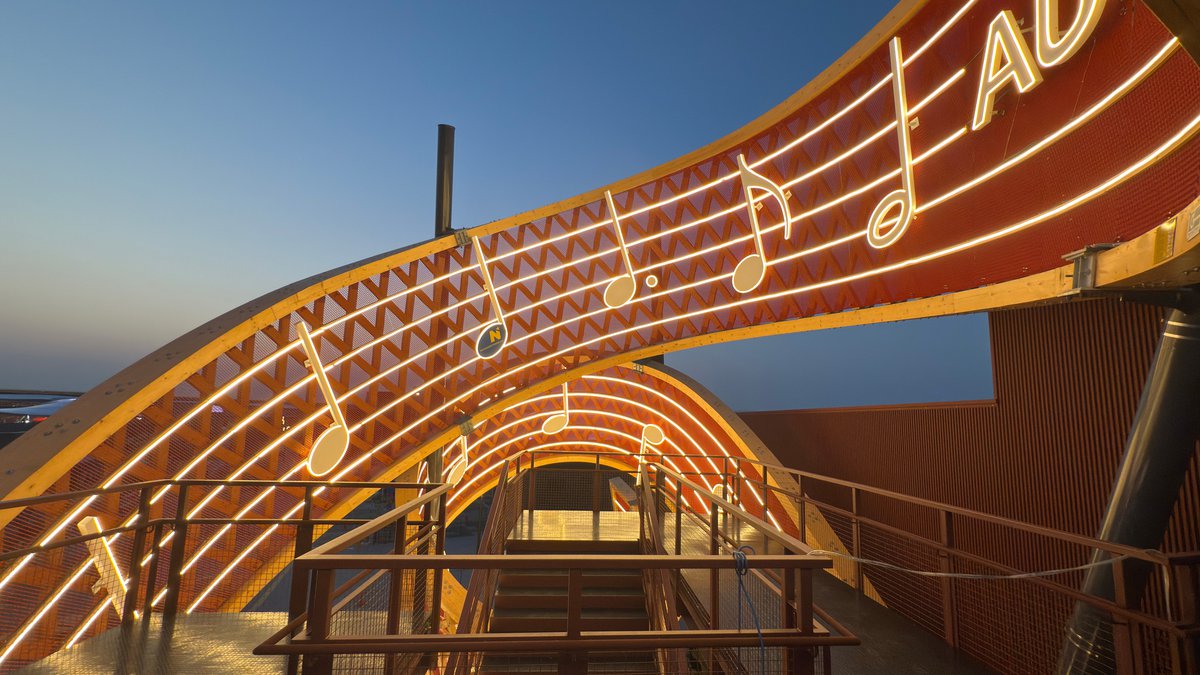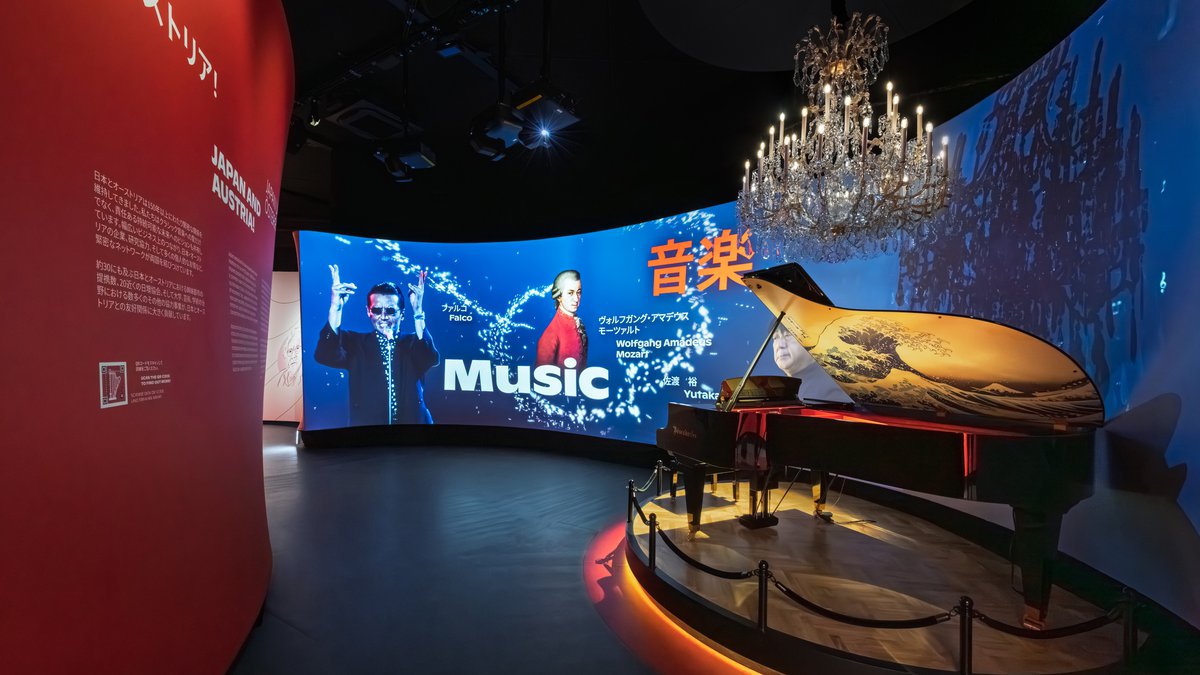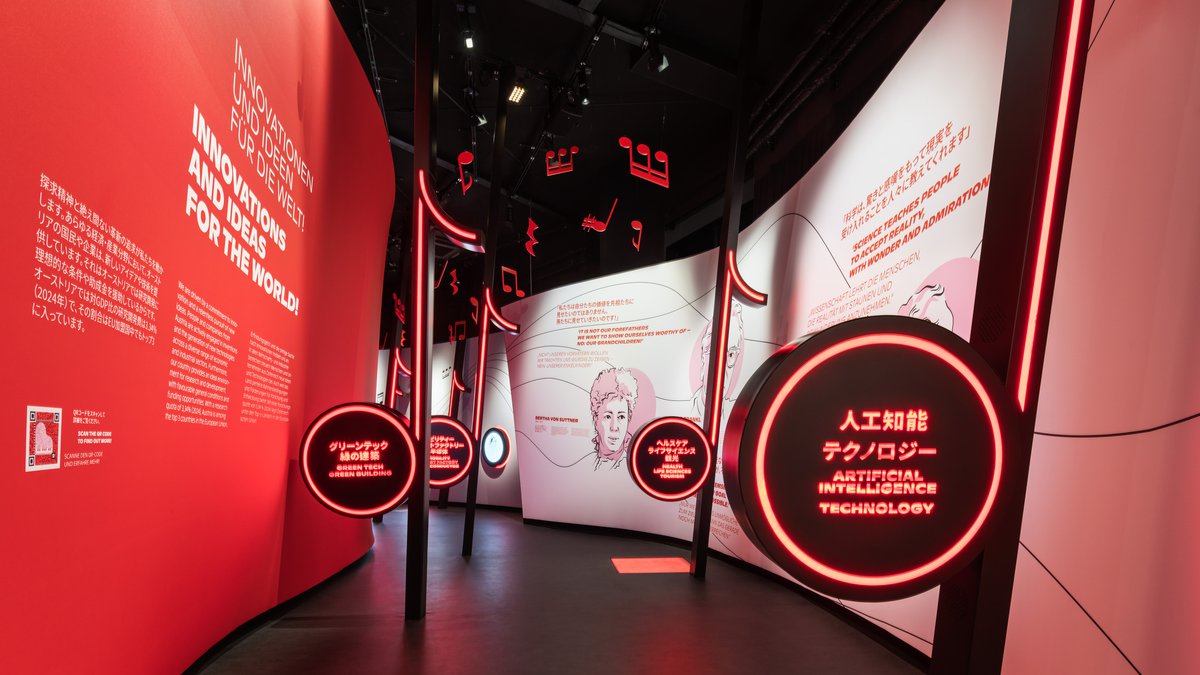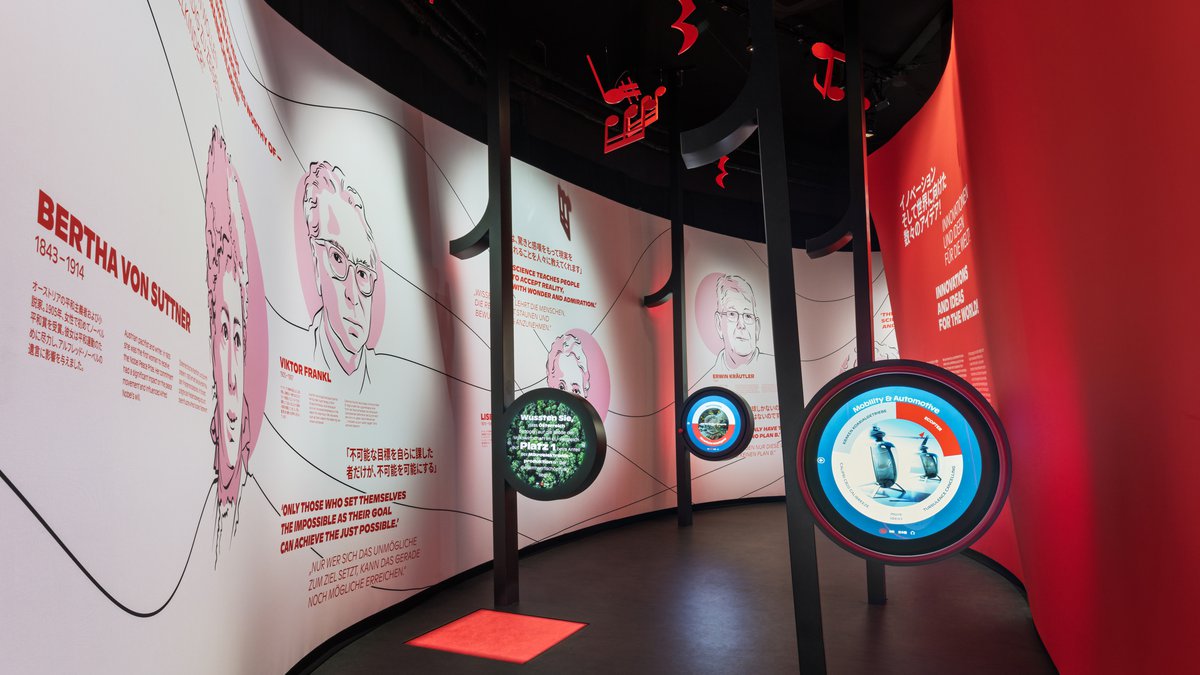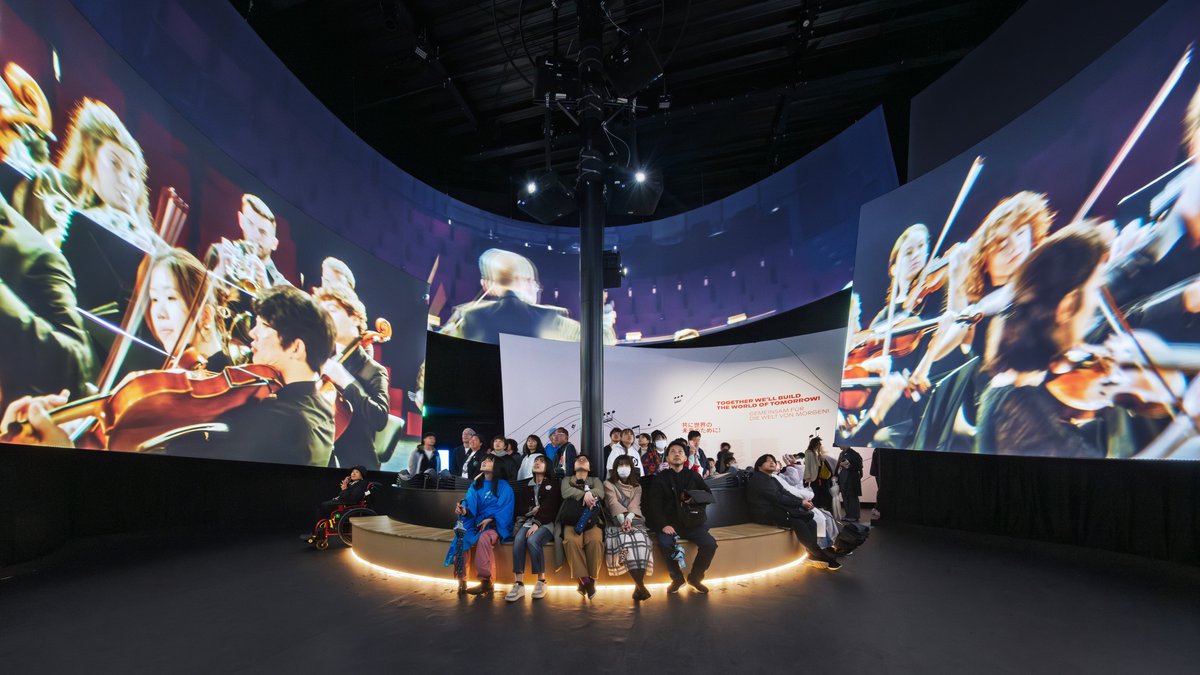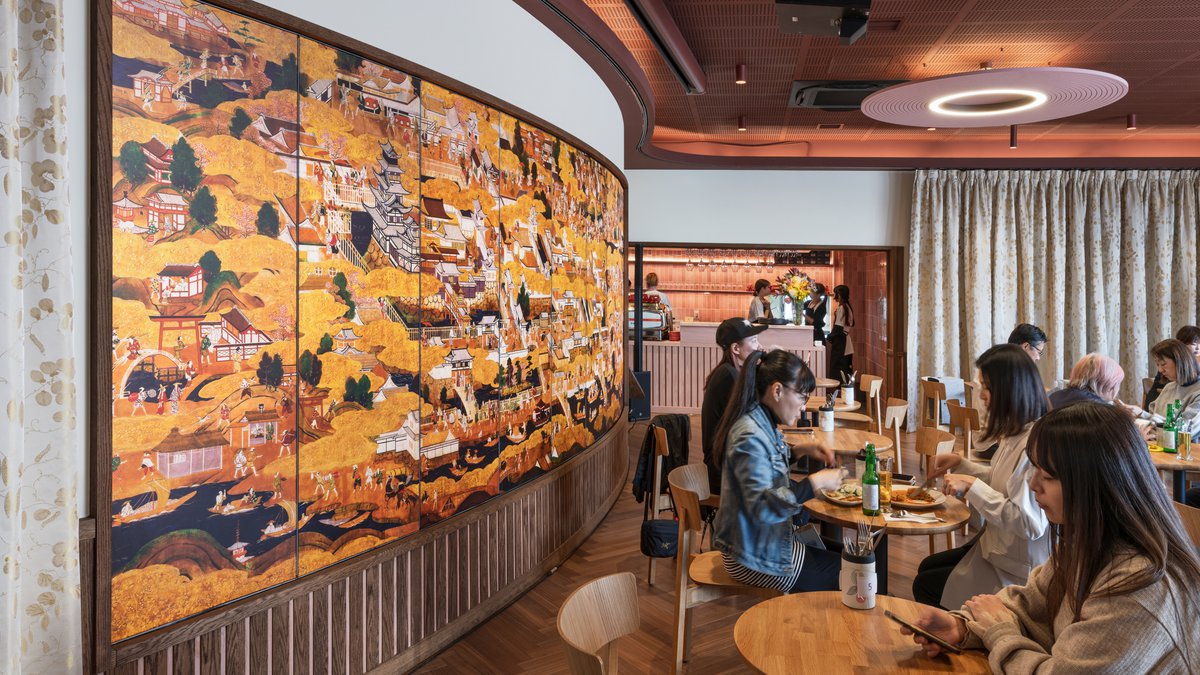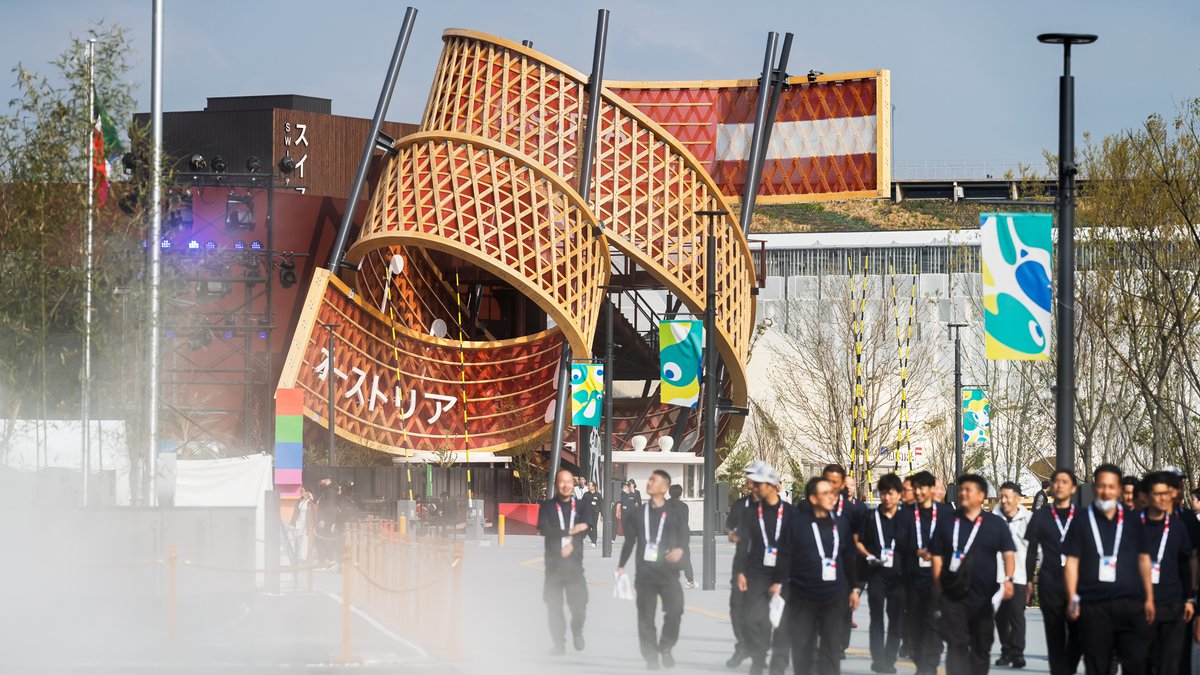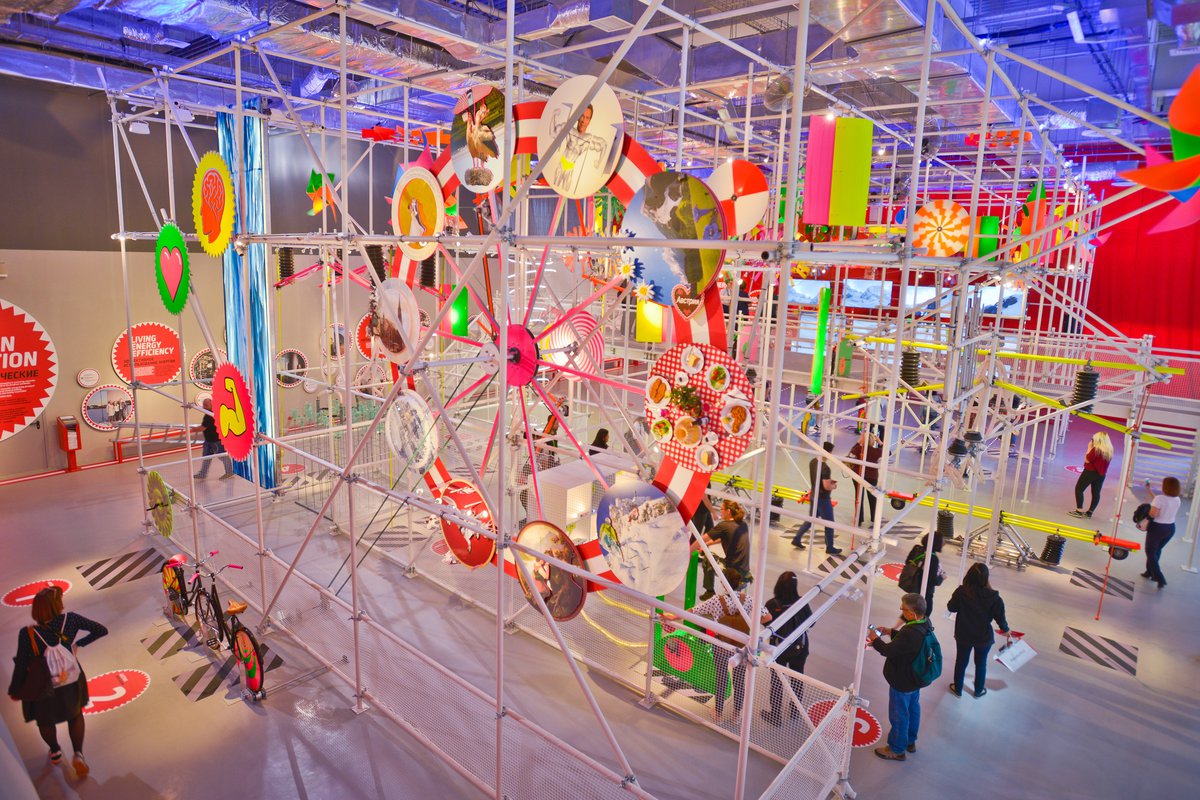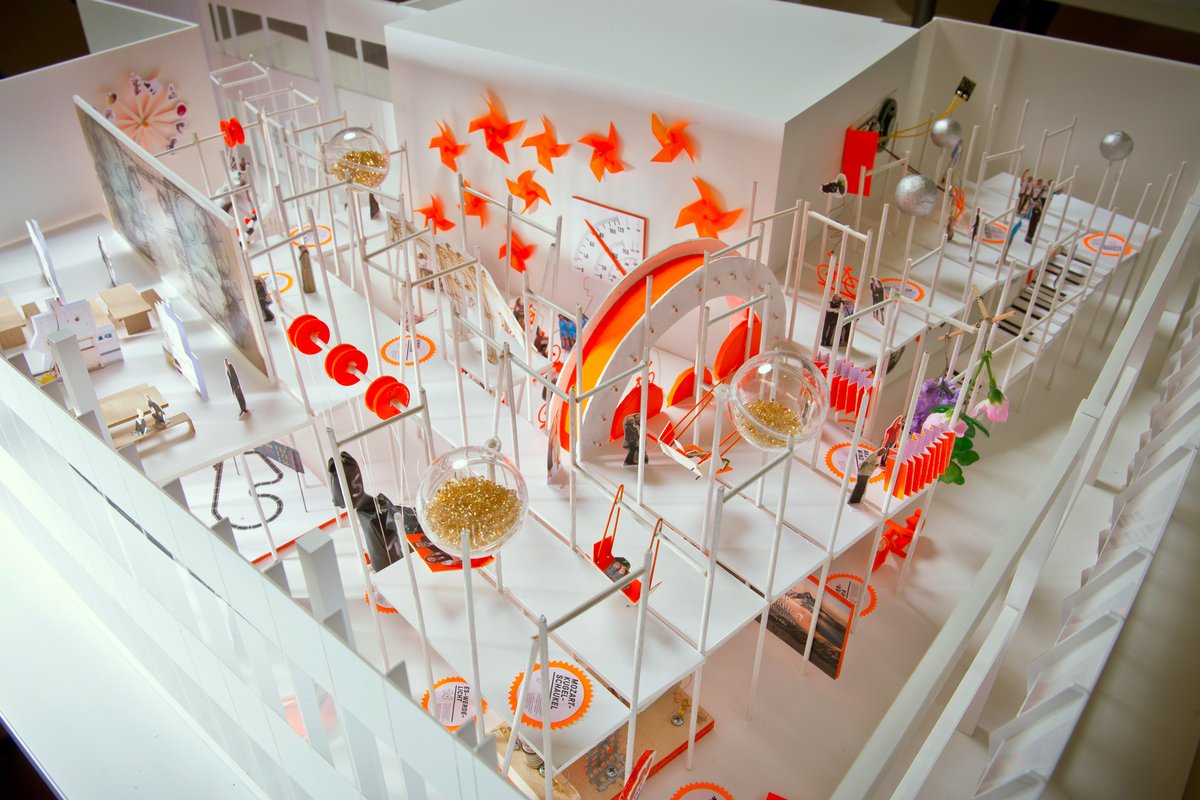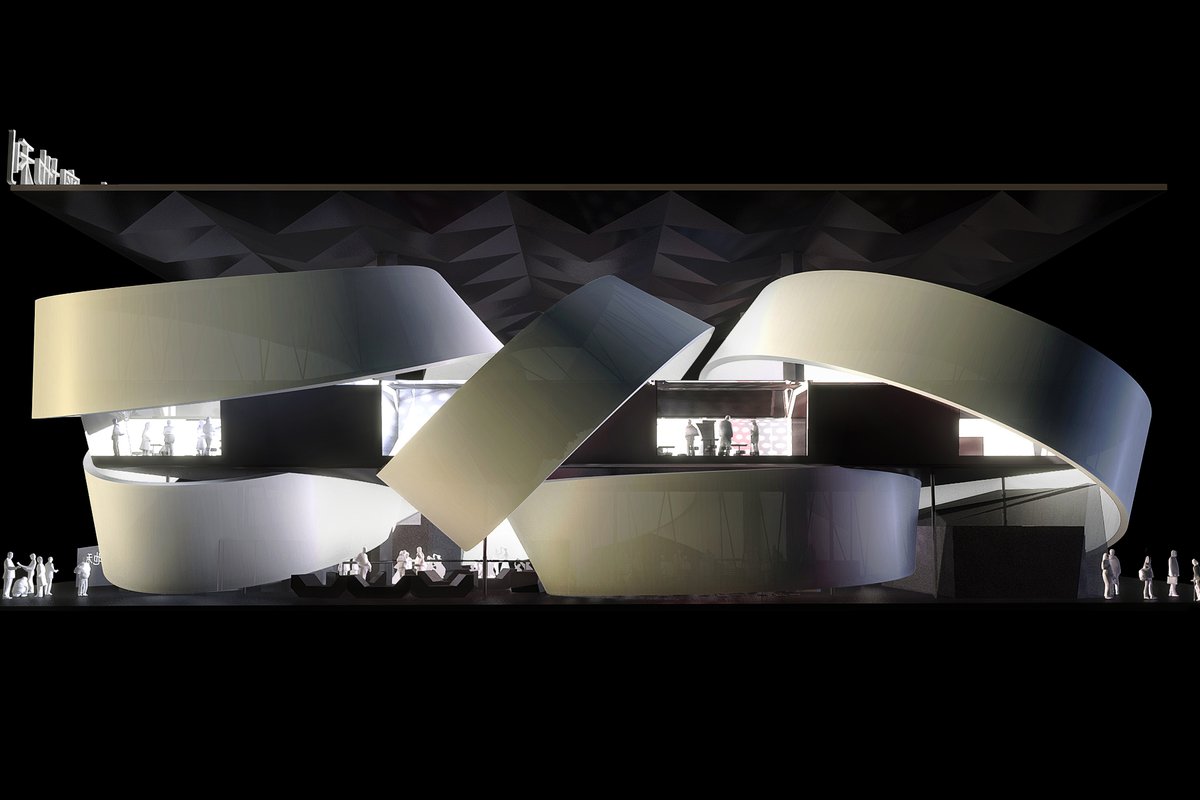Austrian Pavilion EXPO 2025 Osaka
Austria. Composing the Future.
The World Expo – “Expo 2025” – is held in Osaka from 13 April to 13 October 2025. BWM Designers & Architects, in collaboration with facts and fiction, won the two-stage realisation competition for the design of the Austrian pavilion. The concept is a musical interpretation of the Expo’s motto – „Designing Future Society for Our Lives“. The idea is that, in Austria, the future is not „designed“, but rather composed: „Austria. Composing the Future“.
The Austria Pavilion comprises two main elements: the monumental spiral sculpture in the forecourt and the functional pavilion building housing the exhibition space, behind the spiral.
The pavilion’s storyline: Composing the Future
An iconic spiral sculpture rises dramatically into the air, serving as the visual centrepiece of the Austria Pavilion at the World Expo. Viewed up close, it reveals itself as an oversized wooden musical staff featuring the opening bars of the Ode to Joy. The spiral holds a universal symbolic power that transcends cultures. It invites reflection on the cyclical nature of life, on change, growth and transformation – beyond linear models of progress.
Especially in light of global challenges and increasing anxiety about the future, Austria’s soaring spiral stands as a powerful symbol of joy and optimism. The shape of the spiral is inspired by music – something Austria is especially well known for in Japan. Music brings movement: a twirling waltz, a conductor’s gestures, the rhythm of dance – all of these things are expressed in the spiral. The reverse side of the spiral is designed as a musical staff that rises ever upwards. The opening bars of the Ode to Joy stand for the deep emotional power of music – a force that resonates across cultures and borders.
Beyond that, the choice of this melody is also a cultural statement: as the anthem of the European Union, it reflects Austria’s transnational identity. Austria sees itself as part of a larger whole, where music – as a universal language – builds bridges and brings people together across borders. Beethoven, the composer of this iconic piece, was born in Germany and wrote his works in Austria. And yet, his music doesn’t belong to any one nation, but to the world as a whole.
Composing the Future – a joyful, collective endeavour.
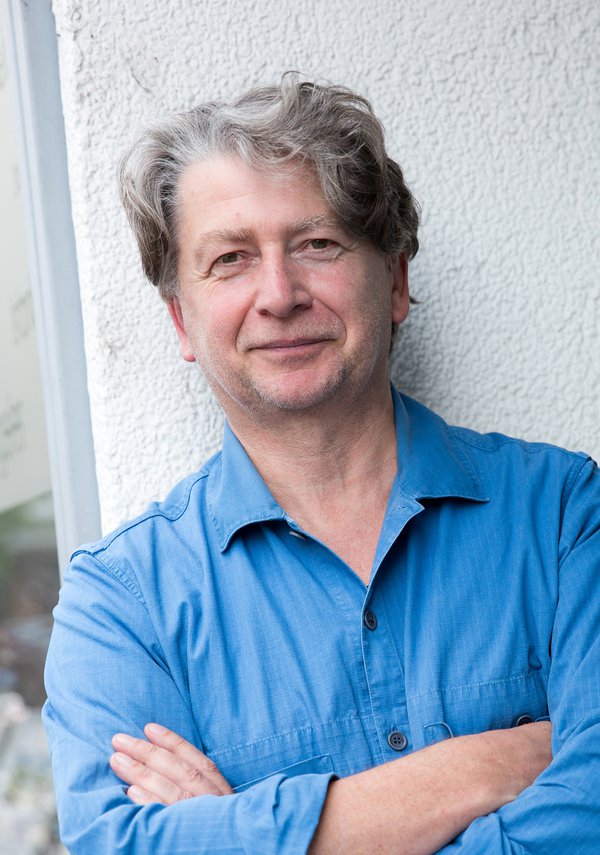
An iconic spiral sculpture rises dramatically into the air, serving as the visual centrepiece of the Austria Pavilion at the World Expo. Viewed up close, it reveals itself as an oversized wooden musical staff featuring the opening bars of the Ode to Joy.Johann Moser
The spiral.
The standout feature of the Austria Pavilion is an eye-catching spiral sculpture that stretches up to the sky. Made of wood, it showcases Austria’s expertise in modern timber construction and highlights how this traditional material is making a big comeback as a sustainable alternative in light of the global shift towards minimising CO₂ emissions. Wood bridges tradition and innovation in a unique way.
The 91m-long, 4.3m-wide “ribbon” consists of an upper and a lower edge that are interlaced with 265 diagonal struts. The double-looped form is supported by five steel pylons and rises to a height of 16m. The inner surface of the spiral is designed as a musical staff, featuring the opening bars of Beethoven’s Ode to Joy. On the outside, the bare timber construction is on full display – complete with all its joints and structural details.
The wooden spiral was built by an Austrian company based in Horn (Lower Austria). It was then taken apart and the segments shipped in ten containers. After arriving in Japan, the structure was assembled with great precision by a local timber construction firm – a prime example of a successful collaboration between Austrian and Japanese timber construction experts.
The execution of this monumental sculpture was technically demanding and required state-of-the-art planning, calculation and manufacturing methods. One of the unique features is the construction method using screwed wooden slats made from certified Austrian spruce. Thanks to the principle of “screwing instead of gluing”, the entire structure is completely demountable and reusable, which allows for the sustainable use of the materials beyond Expo 2025.
The pavilion building.
The pavilion building, which connects directly to the wooden spiral, was constructed as a functional modular steel structure. It can be easily disassembled into its constituent parts and reused after the Expo. Covering a footprint of 490m², the single-storey exhibition hall is divided into three spaces, the third of which, with a height of 11m, contains an immersive multimedia installation that marks the grand finale of the experience.
The first floor houses offices and a VIP lounge. On the second floor, a café with seating for up to 50 guests offers a place to unwind and space for events. Visitors access this area via a striking staircase that is integrated into the wooden sculpture and that continues up all the way to the fourth floor, culminating in an observation deck.
The forecourt in front of the pavilion features a welcome kiosk, a little shop and a culinary treat: freshly made takeaway Kaiserschmarrn. Visitors can enjoy a little piece of Austrian food culture as they wander the Expo grounds.
Why is the spiral made of wood?
Besides music, Austria and Japan are united in their deep appreciation for traditional craftsmanship – particularly in timber construction. As a building material, wood is both classic and highly modern and forward-looking. Given the increasing need to reduce CO₂-intensive construction methods, wood plays an ever-growing role. Austria boasts exceptional expertise in this area and is recognised as a global leader in modern engineered timber construction. The spiral sculpture embodies the excellence of Austrian timber craftsmanship while also serving as a prime example of sustainable architecture. The soaring structure seems to defy gravity, giving the impression that the material is flying …
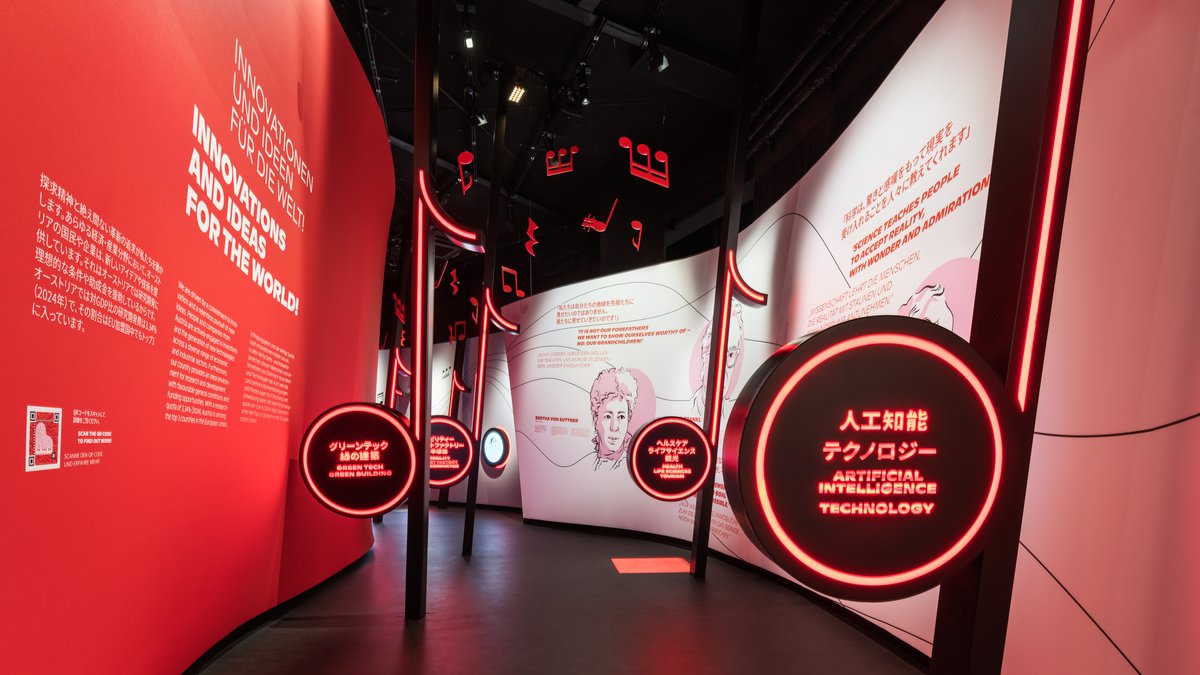
The exhibition.
The exhibition inside the pavilion is spread across three rooms. In the first space, the music staff comes to life and turns into a projection surface. Here, visitors experience the richness of the relationship between Austria and Japan in a captivating musical opening. From there, they move on to oversized interactive notes, where they can playfully explore the diversity and strengths of Austria’s economic and societal landscape. The final room marks the highlight of the exhibition: the Cathedral of the Future. In this space, visitors engage interactively with the future and are invited to participate in composing it – in line with the motto ‘Composing the Future’.
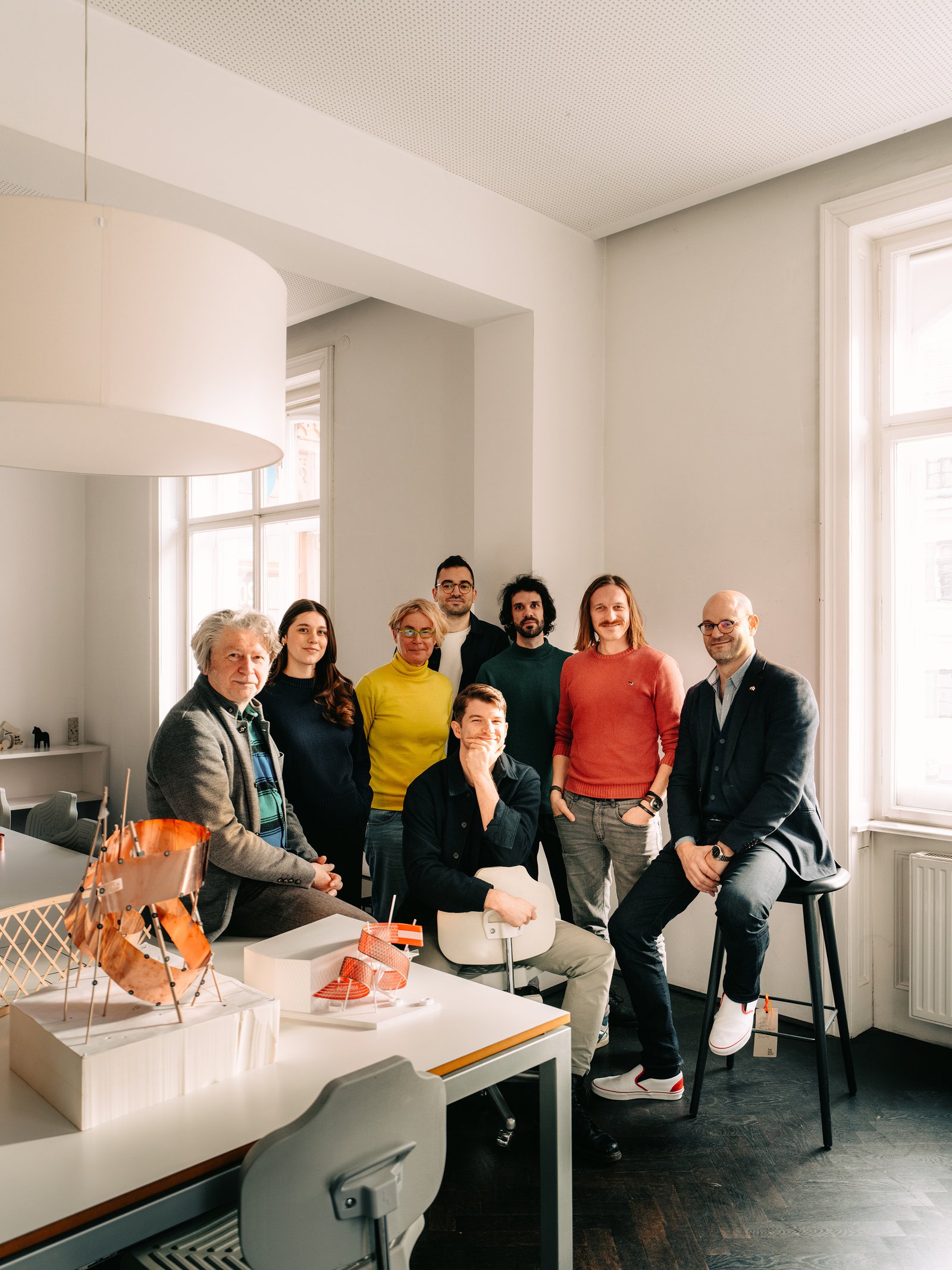
Conclusion: Austria’s offering at Expo 2025 – Designing Future Society for Our Lives "COMPOSING THE FUTURE"
1. Symbol: Optimism and hope. The spiral sends a strong message of optimism and joy – a symbol that speaks to movement, change and progress across all cultures.Music: Connection and inspiration
2. Music: Connection and inspiration. Much like dynamics in music, the spiral rises ever upward. Music knows no borders and unites people – just as Austria sees itself as a bridge between cultures.Wood: Building for the future
3. Wood: Building for the future. As a material rooted in tradition yet firmly geared toward the future, wood stands for sustainable construction and the mindful use of resources. The spiral exemplifies Austria’s leading role in state-of-the-art timber construction.
Task
Architectural design and development of the general theme, as well as conception and design of the exhibition
Date
04/2025
BWM Team
Johann Moser, Hubert Meyer, Kinga Baluch, Mihael Barada, Maria Schattowich, Clemens-Veit Hörl, Luka Rados, Felicitas Wiesinger, Dominika Markowicz, Livia Hämmerle, Paul Gaunersdorfer
Image credit
Expo Austria
Stefan Schilling
Carlo Teofilo
Julius Hirtzberger
BWM Designers & Architects
Participants
Client
Bundesministerium für Arbeit und Wirtschaft (Federal Ministry of Labor and Economics), Wirtschaftskammer Österreich (Austrian Federal Economic Chamber), EXPO-Büro Wirtschaftskammer Österreich (Alf Netek, Helmut Döller)
Project control
Werner Consult Ziviltechniker GmbH
Design-build
BWM Designers & Architects, Vienna
Overall concept, narration
BWM Designers & Architects, Vienna, with facts and fiction, Cologne
Architectural design
BWM Designers & Architects, Vienna
Structural engineering
Werkraum Ingenieure ZT GmbH, Vienna
Building services planning
Energytech Ingegneri S.r.l., Bolzano
Building physics
K2 Bauphysik GmbH, Vienna
Landscape design
Simma Zimmermann Landschaftsarchitektinnen, Vienna
Exhibition design
facts and fiction, Cologne
Content creation
facts and fiction, Cologne, and Zone Media, Vienna
Musical direction
Kling Klang Klong, Berlin
Compositions and recordings
Mozarteum, Salzburg
Programming
GROSSE8, Cologne
Media planning
BeWunder, Berlin, Dubai
General contractor
Nüssli Group, Switzerland
Construction company
Tekken Corporation, Japan
Local planner
MORF Inc., Japan
Timber ribbon – Production and logistics
Graf Holztechnik, Horn
Timer ribbon – assembly in Osaka
Shinohara, Japan
Media technology
BeWunder, Dubai
Exhibition construction
ShowTex, Dubai
Interior finishing and exhibition construction
dDf, Istanbul, Turkey
Logistics/Transport of ribbon
Cargo-Partner
Awards
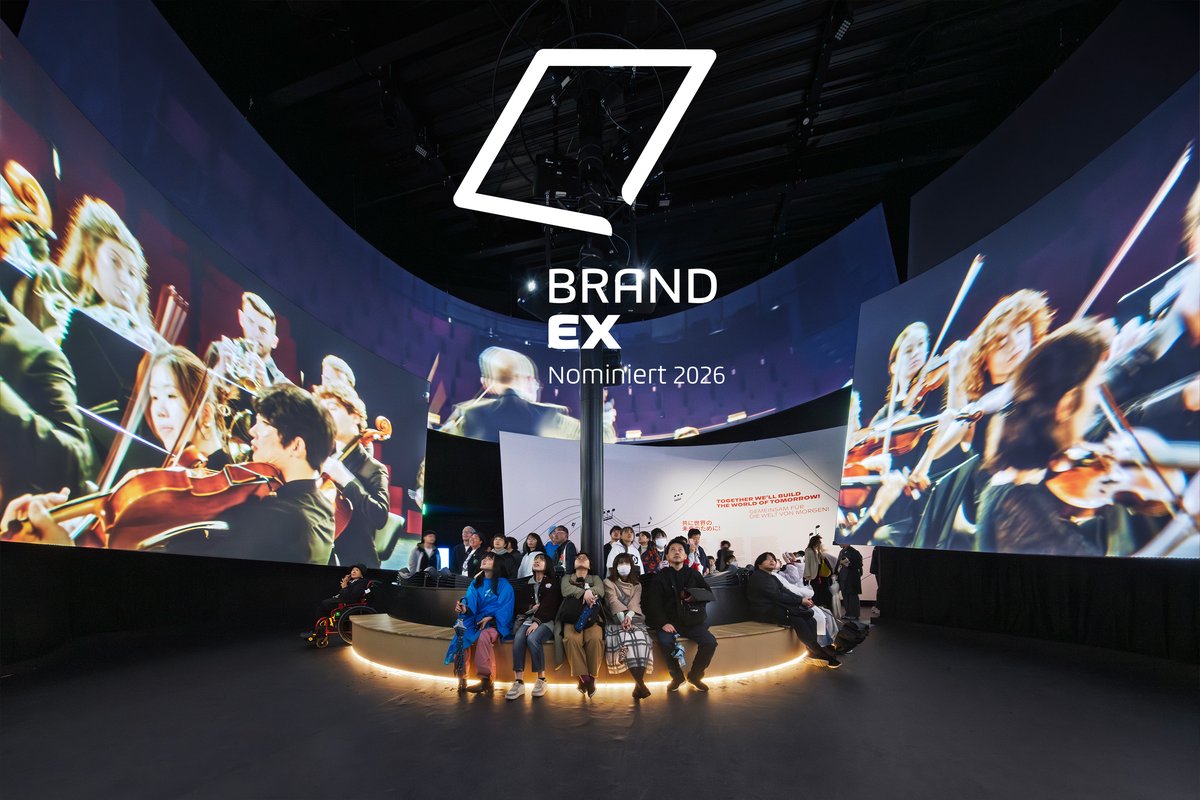
3 December 2025
Shortlist!
We are delighted to have made it to the third stage of the BrandEx Awards and onto the shortlist! The final decision on whether the Austria Pavilion will win gold, silver or bronze will be made at the awards ceremony in January.
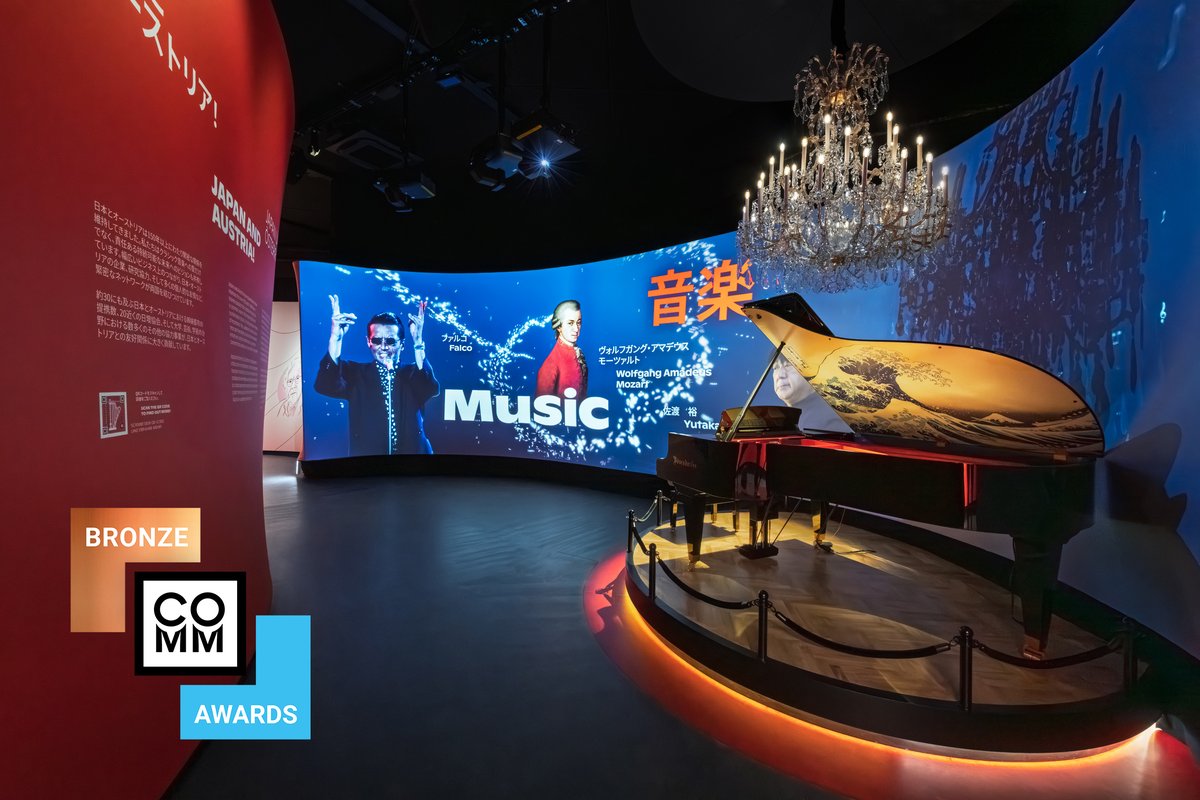
28 November 2025
Bronze!
We are delighted that our project won bronze in the ‘Space Exhibition’ category at the CommAwards 2025! Congratulations to everyone involved!
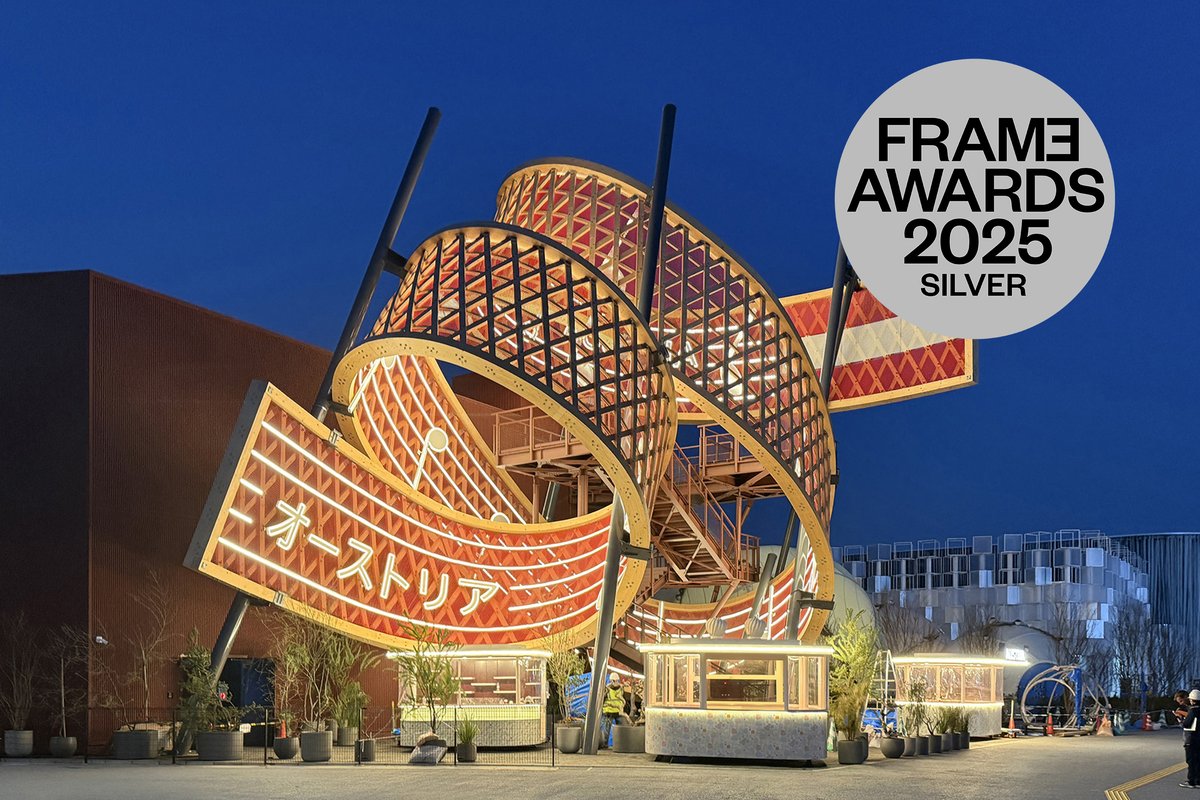
19 November 2025
FRAME Awards 2025
We are excited to share that our project, the Austrian Pavilion EXPO 2025 Osaka, has been awarded silver in the ‘Cultural Space’ category at the FRAME Awards 2025! Congratulations to the entire team and everyone involved!
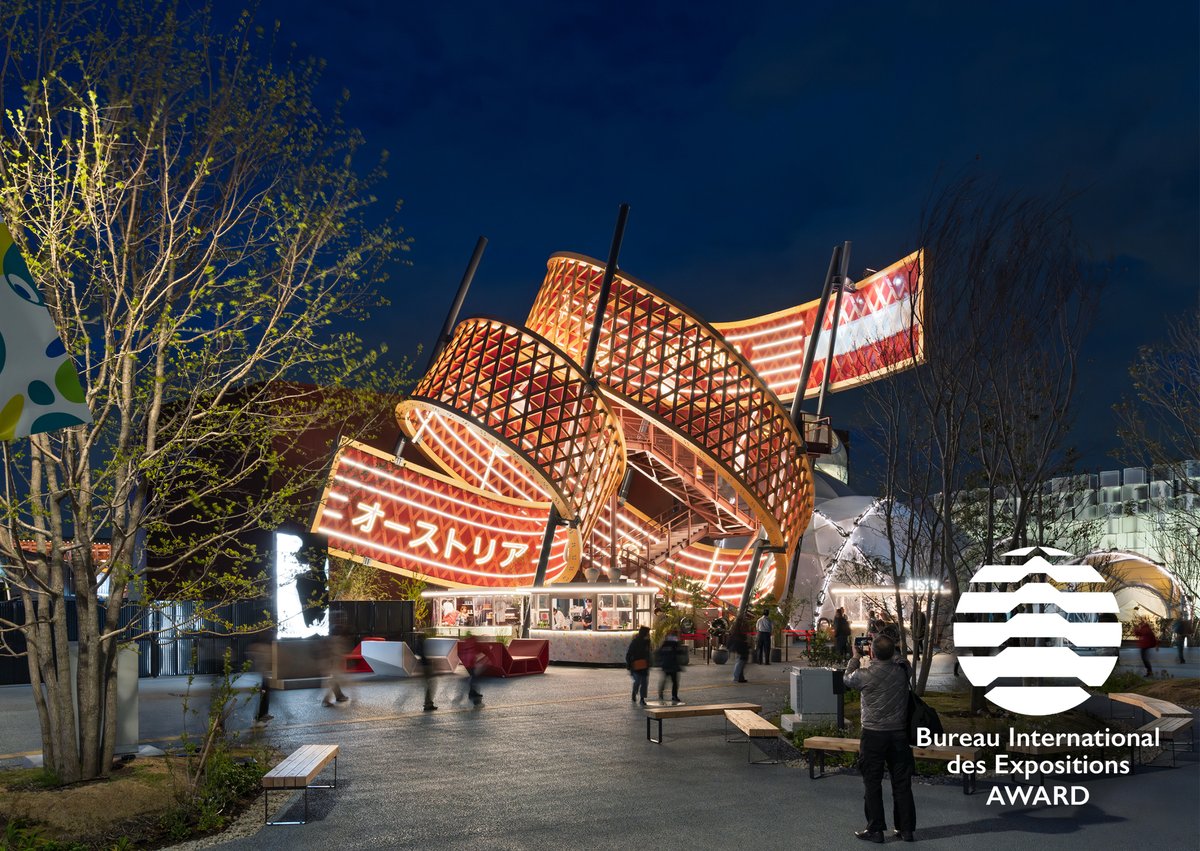
23 October 2025
Bronze!
Bronze for the Austria Pavilion! At the BIE Awards of the Bureau International des Expositions, our pavilion for EXPO 2025 Osaka won bronze in the category ‘Exhibition Design Self-built Pavilions’ – we are delighted and congratulate everyone involved in the project!
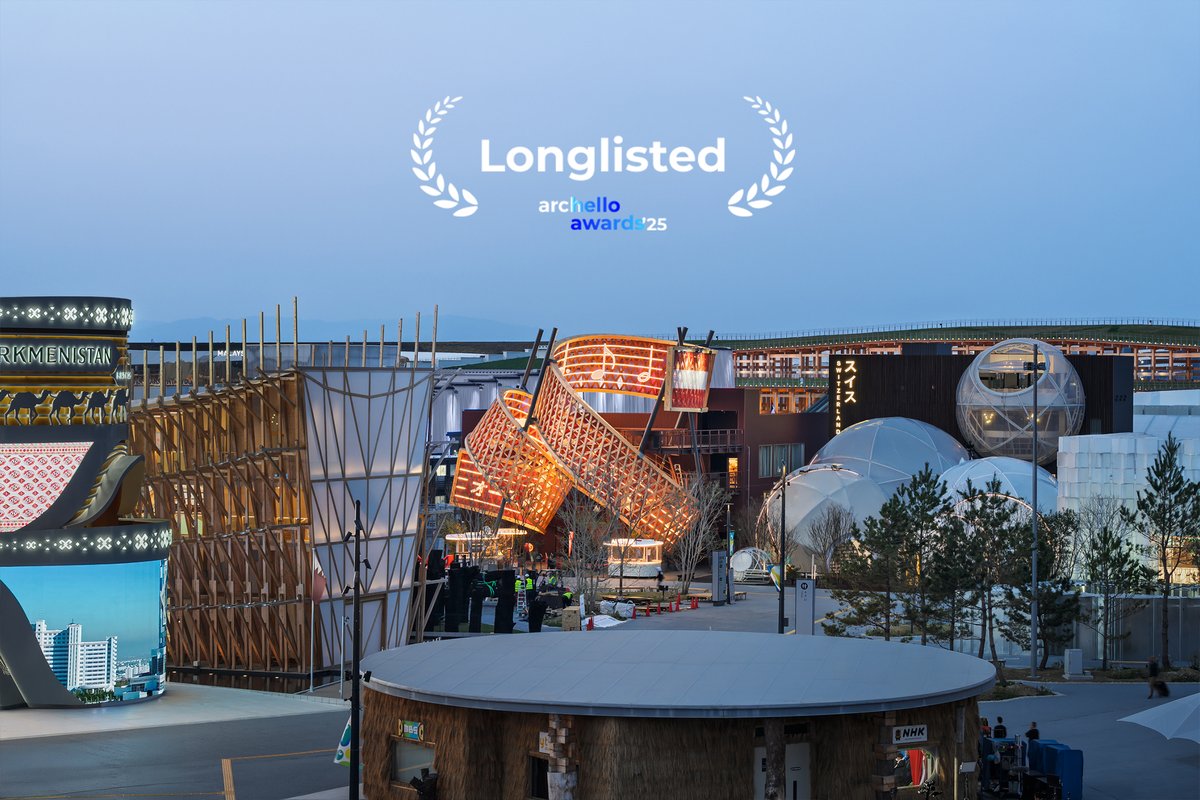
16 October 2025
Longlist!
We are excited to share you that our project, Austrian Pavilion EXPO 2025 Osaka, has been selected for the Archello Awards 2025 Longlist in the "Pavilion of the Year - Temporary" category. Congratulations to everyone involved!
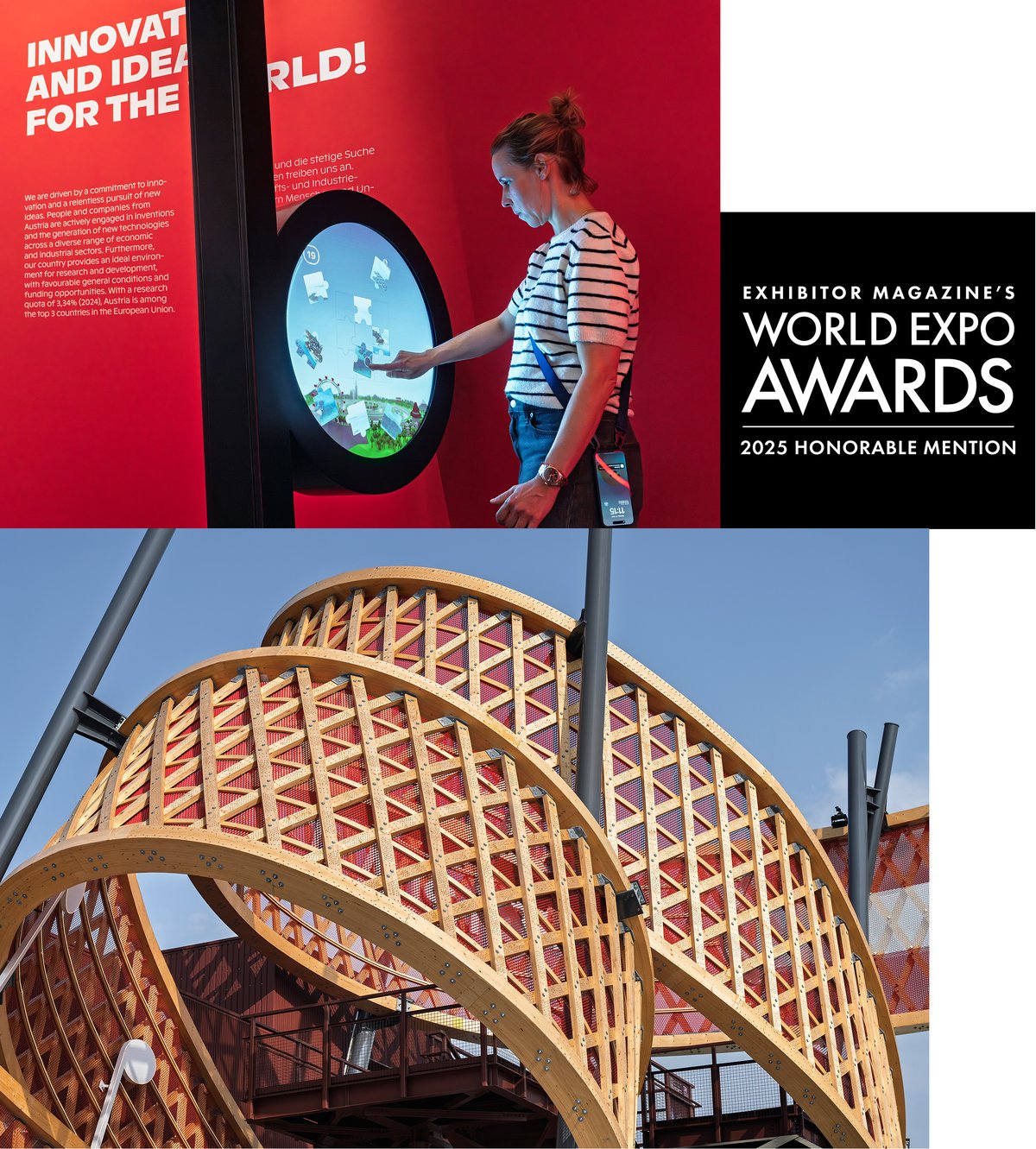
13 October 2025
World Expo Awards
The World Expo Awards were announced by Exhibitor Magazine: Our pavilion received an honourable mention in the categories ‘Best Exterior Design’ and ‘Best Presentation/Storytelling’.
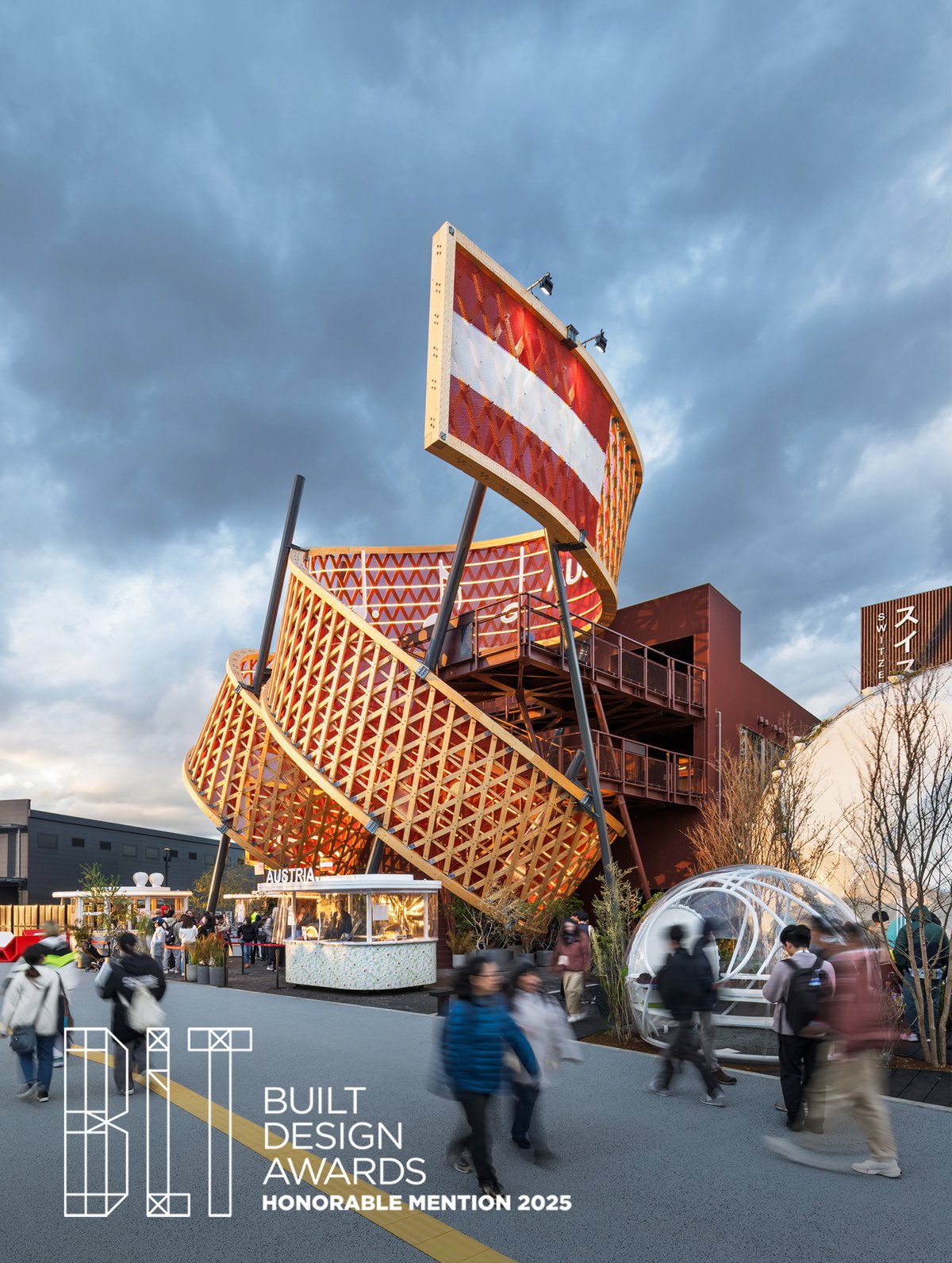
10 October 2025
BUILT Design Awards 2025
At the BUILT Design Awards 2025, the Austrian Pavilion received an Honourable Mention in the Architectural Design/Cultural category. We are delighted and congratulate everyone involved!
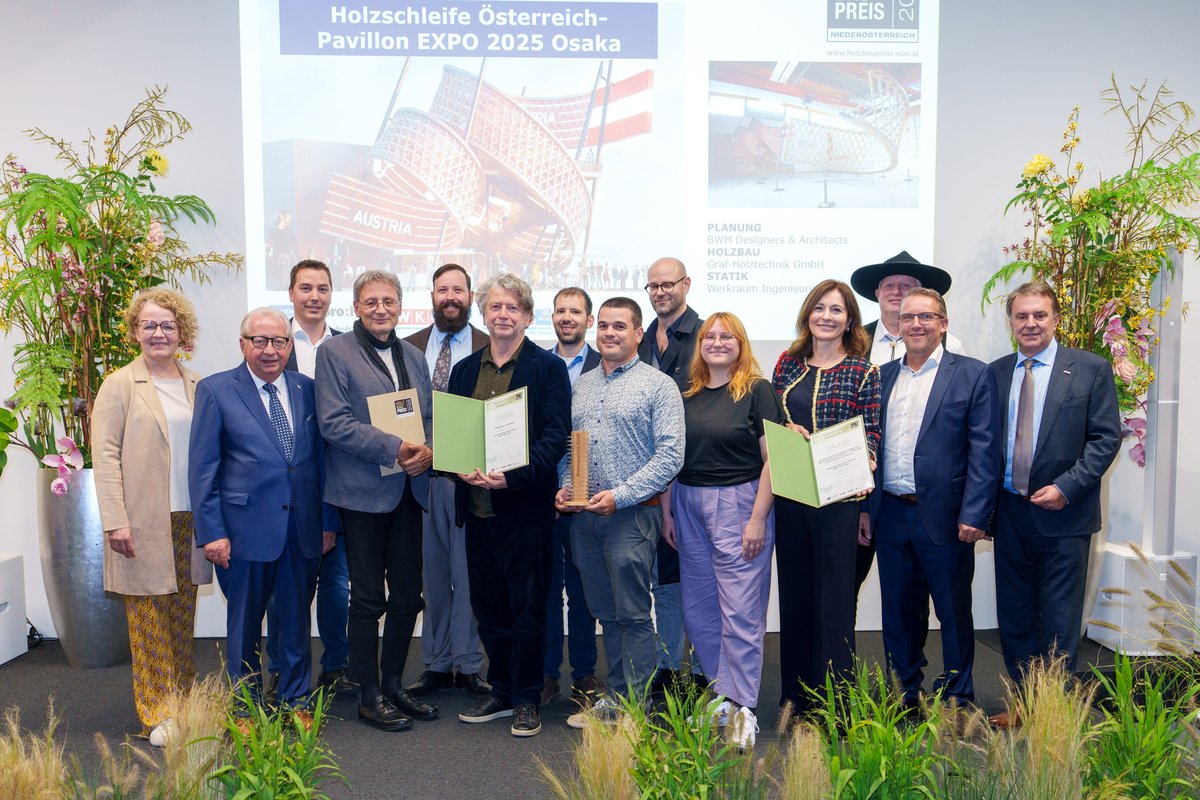
26 September 2025
NÖ Holzbaupreis 2025
The wooden loop for the Austrian Pavilion at EXPO 2025 Osaka was awarded the special prize in the “Public and Municipal Buildings” category at the Lower Austrian Timber Construction Awards 2025. Congratulations to everyone involved!
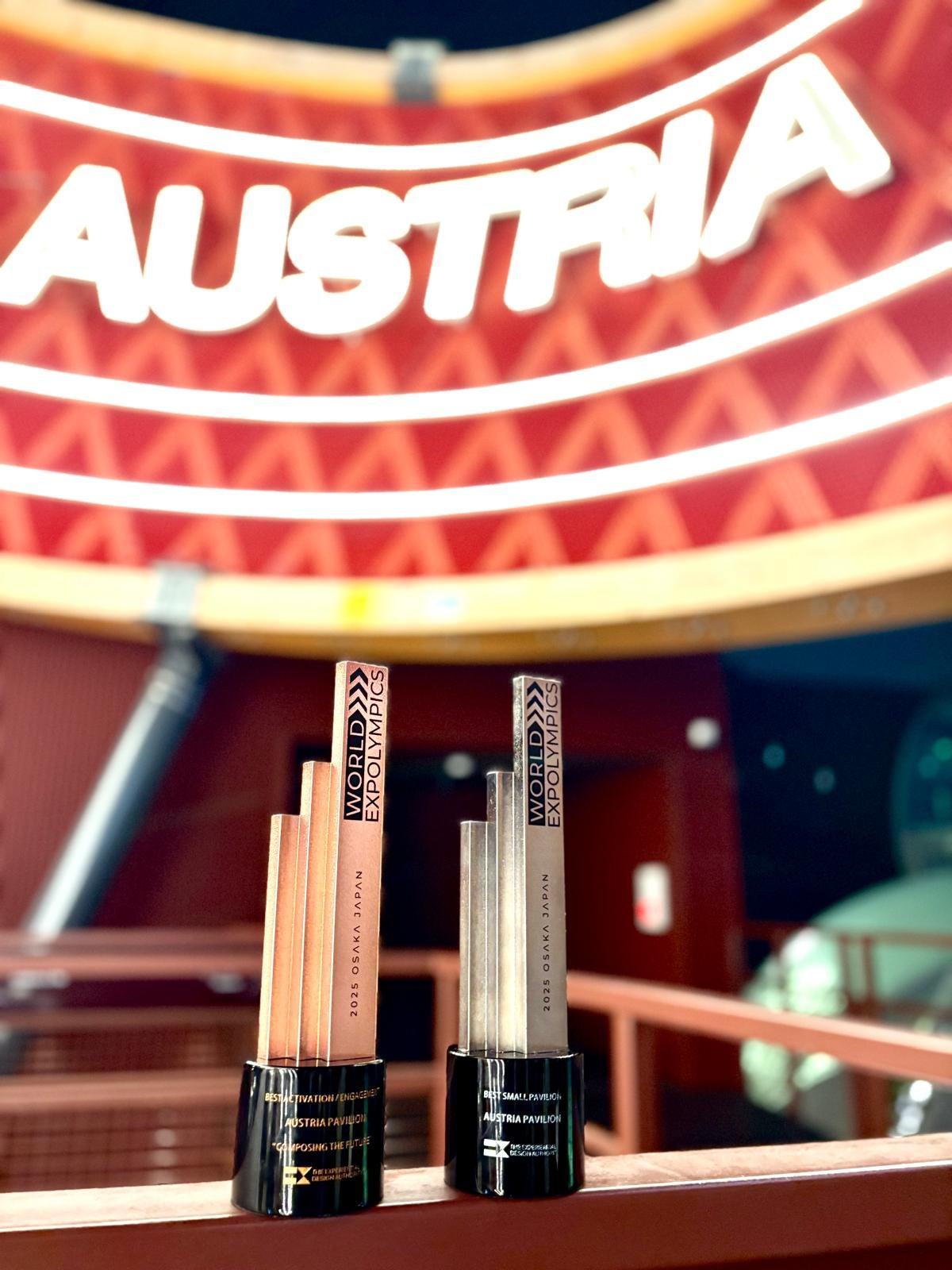
25 September 2025
World Expolympics Winner!
We are excited to share that the Austrian pavilion at EXPO 2025 Osaka was awarded silver (Best Small Pavilion) and bronze (Best Activation for Engagement: Composing the Future) at the World Expolympics. Congratulations to everyone involved!
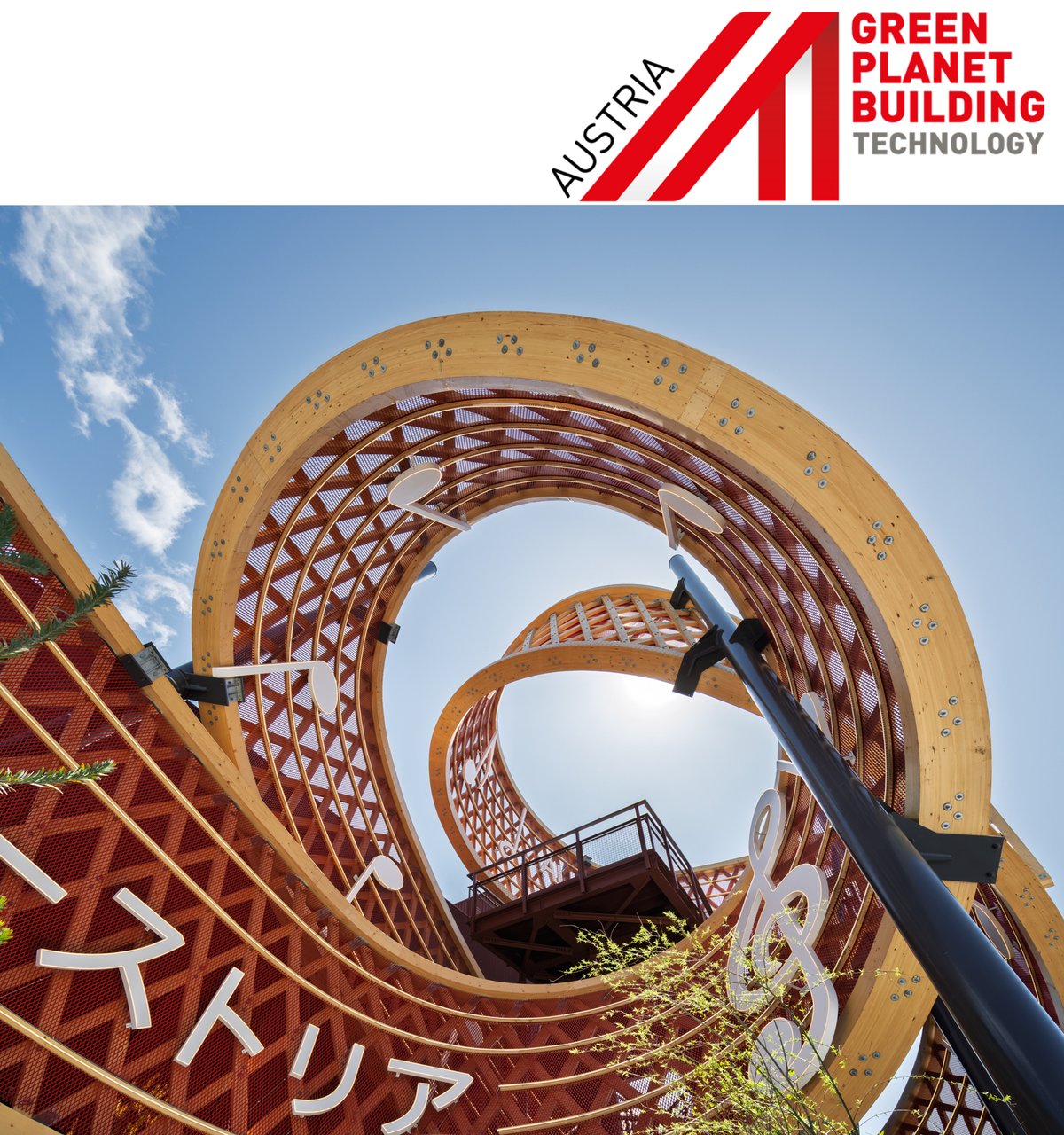
9 September 2025
Austrian Green Planet Building Award!
The wooden spiral for Austrian Pavilion at EXPO Osaka 2025 has been honored with the Austrian Green Planet Building Technology Award – congratulations and thanks to everyone involved!
Press
11 November 2025
Fachmagazin für Gebäudetechnik
Exportgut Nachhaltigkeit: Green-Building-Projekte
Link PDF1 October 2025
Archdaily
12 Pavilions at EXPO 2025 Osaka Highlight Immersive Spatial Experiences
Link PDF15 September 2025
Madera Sostenible
“La sostenibilidad no es una opción, sino un principio de diseño inherente desde el inicio a cada proyecto”
Link PDF14 July 2025
vol
Expo 2025: Großer Andrang vor dem Österreich-Pavillon in Osaka - Japaner sind begeistert
Link PDF5 June 2025
topleader
Österreich-Pavillon der Weltausstellung in Osaka setzt kraftvolles Zeichen
Link PDF14 May 2025
https://verliebt-in-japan.de
Die Expo 2025 in Osaka und der österreichische Pavillon – „Austria. Composing the Future
Link24 April 2025
Die Presse
„Composing the Future“: Österreichs Pavillon auf der Expo in Osaka
Link PDF19 April 2025
Parametric Architecture
Austria Pavilion by BWM Designers & Architects at Expo Osaka 2025
Link18 April 2025
Arcdaily
BWM Architects Explores Musical Heritage For Austria Pavilion at Expo Osaka 2025
Link PDF14 April 2025
der Standard
Expo 2025: Musik gibt bei Österreichs Kulturprogramm den Takt vor
Link PDF13 April 2025
Finanzen.at
Expo in Osaka eröffnet - Österreich mit Pavillon vertreten Die Expo 2025 in Osaka
Link10 April 2025
OTS
BIG IN JAPAN. MAK bringt Felice Rix-Ueno auf die Expo 2025
10 April 2025
NHK Japan
Kurz vor der Eröffnung der Expo: Pavillons aus verschiedenen Ländern und Regionen
Link1 April 2025
OTS/WKO
WENDY JIM stattet Team des Österreich-Pavillons bei der EXPO 2025 in Osaka aus
Link PDF19 March 2025
Salzburger Nachrichten
Expo: Österreich setzt auf Mix aus Tradition und Innovation
Link19 March 2025
der Standard
Mit Sängerknaben, Hightech-Bösendorfer und Waldviertler Holz zur Expo nach Japan
Link19 March 2025
Börse Express
Wirtschaft, Innovation und Kultur: Umfassendes Programm zur EXPO 2025 Osaka präsentiert
Link17 March 2025
La Vie
Osaka Expo 2025 „Österreich-Pavillon“! Ein spiralförmiges, fünfzeiliges Musikgebäude, das die Zukunft mit Musik schreibt.
Link27 February 2025
diplomacyandcommerce.at
EXPO 2025 Osaka: Österreich-Pavillon vereint Tradition und Innovation im Kulturprogramm
Link18 February 2025
Böse-express.com
EXPO 2025 Osaka: Österreich-Pavillon vereint Tradition und Innovation im Kulturprogramm
Link9 December 2024
OTS WKO
Zukunftsweisende österreichische Innovationen auf der EXPO 2025 in Osaka
Link5 December 2024
lifescienceaustria.at
WKO: Zukunftsweisende österreichische Innovationen auf der EXPO 2025 in Osaka
PDF5 December 2024
boerse-express.com
Zukunftsweisende österreichische Innovationen auf der EXPO 2025 in Osaka
Link2 November 2024
Oberösterreichische Nachrichten
Expo 2025: Pavillon mit hölzernem Notenband
Link PDF28 October 2024
LOK Report
Cargo-Partner: Transport einer spektakulären Holspirale zur EXPO 2025 in Osaka
Link28 October 2024
Boerse-express.com
Ein Notenband aus Holz für die Weltausstellung EXPO 2025: Wahrzeichen des Österreich-Pavillons präsentiert
Link28 October 2024
stadtlandzeitung.com
Niederösterreichisches Holzband für Österreich-Pavillon zur EXPO 2025 präsentiert
Link28 October 2024
kurier.at
Pavillon mit hölzernem Notenband aus Niederösterreich bei der Expo 2025
Link22 July 2024
Parametric Architecture
BWM Architects revealed design for the Austrian Pavilion at Expo Osaka 2025
Link18 July 2024
Archdaily
BWM Architects Explores Musical Heritage For Austria Pavilion at Expo Osaka 2025
Link28 May 2024
Kyodo News
(Pavilion)Austria pavilion to feature music under theme "composing" future
Link PDF19 December 2023
Boerse-express
Weltausstellung 2025 in Japan: Österreich reicht Bauantrag für seinen Expo-Pavillion in Osaka ein
Link PDF3 July 2023
Austria-Architects
